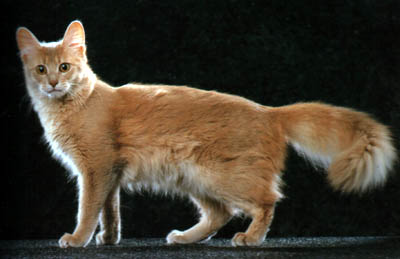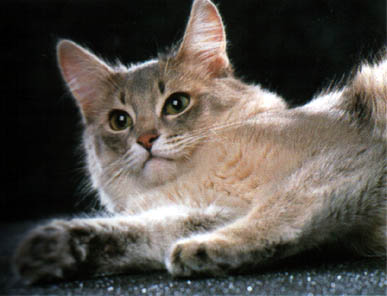Somali
The Somali is quite simply a longhaired Abyssinian. Some people believe they are the result of crosses between Abyssinians and Persians, others that is due to the accidental presence in an Abyssinian of the gene that determines long hair, as has been seen occasionally in other shothaired breeds. Normally a breeder finding a longhaired kitten in an Abyssinian litter would eliminate it as not conforming to the standard and never mention it again.
In 1930, however, an American breeder had two simultaneous litters, from different queens, each of which contained a longhaired kittens, one male and one female. As soon as possible they were mated and so were their offspring in their turn. And the day came when litters from this line produced only longhaired cats. In 1963 the Somali was given official recognition as a breed. Today it can be seen at cat shows everywhere and is deservedly succesful.
The Somali has kept all the best features of the Abyssinian. An elegant mover, it instinctively knows how to pose to the best advantage. Demanding of both its owner's affection and time it, too, can genuinely mope if its owner appears to neglect it, or is away for any length of time. It is obedient to its owner's slightest command, however quietly or unobtrusively given. It is tottaly unaggressive, unless really provoked, and prefers to go away rather than show the slightest bad temper.
But the Somali has its own characteristics too. The coat is very soft to the touch and ruff and plumed tail are points in favour of long hair. More affectionate and less reserved than the Abyssinian, and playful with children, it really intergrates itself into the family.
An ecellet hunter, it knows how to be patient and cunning. It should be noted that the Somali is vulnerable to sudden changes of temperature and to draughts. If the cat is to be kept in an apartment, a constant, gentle room temperature should be maintained.
The Somali grooms itself, being a naturally clean cat, and only needs a quick brush over in the morning. Left to itself it would eat nothing but meat. To combat a tendency to obesity, however, it needs a balanced diet which from time to time includes fish. If it is to be kept without the benefit of a garden it should at least have the doors left open to give free access from room to room : it must have some exercise.
GENERAL
A supple and elegant body with solid limbs and oval feet. The back is rather arched. The plumed, fluffy tail is slightly tapered at the end.
HEAD
Lengthens into a narrow muzzle that is not actually pointed. Medium, wide based ears, always pricked up. The deep, almond shaped eyes, green or golden in color, are full of expression.
COAT
The texture is thick and fine at the same time. The bands of ticking are clearly visible. The color is darkish brown on dark orange. The nose is brick red, outlined in black. Although the breed is established now, it is possible that the odd shorthair wil turn up in a litter one day. The coat does not reach its mature length (medium long) until the cat is eighteen months old.
PICTURES
Information and pictures taken from
'1001 Images of Cats'
1992 Tiger Books International PLC, London
Home | Updates | The Library | F.A.Q | Send Us Your Works | Links




